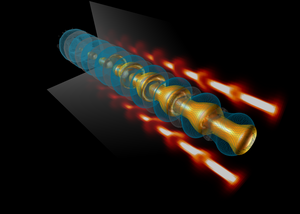Acceleration in the plasma: How does it work?
Large electric fields can be maintained in a plasma, making it a suitable medium to accelerate particles to high speeds. Physicists use a proton beam to generate a charged wave in a plasma.
How does this work? A plasma consists of free, negatively charged electrons and positively charge ions. The proton beam has a positive charge. If a proton beam enters a plasma, it attracts the negatively charged electrons in its vicinity.
The high velocity of the proton beam sets the plasma electrons oscillating. This oscillation produces alternate regions of low and high electron concentrations in the plasma – the positive ions behave in the opposite way. This oscillation moves with the same velocity as the generating proton beam.
If a fast particle is injected at the right moment, i.e. put into the oscillating plasma, it can “ride” the wave and is accelerated. This process can be imagined with the help of an illustration: A fast boat generates a large bow wave which a surfer rides, gaining energy in the process.
It will, however, be a long time yet before we have the first plasma accelerator. The next step will be to further research and perfect the acceleration process – until the electron beams have the quality required to undertake high-energy experiments in the future.
